Story by Roy P. Smith
The Sarthe circuit had changed somewhat since Alpine was last at Le Mans six years previously, so there was new data to acquire in that department. It was even more important that year because the traditional April testing period had been cancelled and no tests could be carried out to set fuel loads, refine the aero set-up, etc (remember there was the long, long Mulsanne straight to cope with here). Fuel consumption dominated everyone’s thoughts. The endurance test at Paul Ricard had been good; the car could go the distance and do it economically. The practice pit-stops had gone well, including the planned tests to change the gearbox at the half-way point in the race (permitted this year). It was warm and sunny. Jean Sage was put in control of the team with François-Xavier Delfosse, on loan from the factory team, in charge of the pits and André de Cortanze and François Castaing in charge of the technical side for calculations, performance, fuel, tyre stops, etc. It was felt that the Alpine Renault had a chance.
One hundred and one cars practiced and the Elf Switzerland-sponsored car for Lella Lombardi/Marie-Claude Beaumont, having been thoroughly checked over and sorted, was the center of a buzz of interest. No Alfa Romeos, no Alpine Renault Turbo, lots of 911 Porsches, and there was the Mirage, but (why not say it?) could a team of women win Le Mans in a French car? It looked good on paper! Practice went well and Gérard Larrousse had tried the car to be sure it was perfectly set up. Larrousse would only be present on the practice days, because he had a commitment to drive the Elf Formula 2 at the Austrian Salzburgring track that weekend. He therefore left the team on the Friday in the hands of Sage and Castaing.The A441-3 had qualified in 8th at 4min 02.9sec, well up the grid. Marie-Claude was scheduled to start.
The start
It was 4 pm on Saturday 14 June, 1975; warm and thankfully dry. As the cars blasted away, the Gulf Mirage GR8s of Vern Schuppan/Jean-Pierre Jaussaud and Derek Bell/Jacky Ickx pulled into an early lead over Reinhold Joest’s Porsche 908/3. Everything in the pit area and the start/finish straight fell silent after the final car had passed. In eager anticipation of the long day and night ahead, the team settled down to wait for Marie-Claude to come by on the first lap. When she did, the car was sounding fine. A few laps passed and Marie-Claude had moved up to 7th, then 6th. Jean Sage and François Castaing looked at each other. Clearly she was running faster than in practice and they started to calculate – remember, there was a new regulation limiting the laps between fuel stops. The car had regularly been running 26 laps between refueling in practice and calculations had been made on this basis.
As the laps were ticked off they were getting nervous, but all was going well so far. 15 laps gone and to Marie-Claude and the team everything seemed to be on schedule. 5 laps later the pit crew made ready with fuel and prepared to receive the car at the end of lap 20. Marie-Claude received the signal the lap before to come in next time round. The timing looked as if lap 20 would also be the fastest lap so far. As she turned onto the Hunaudières straight, heading past the signaling pits and Mulsanne village, there was no sign of any problem.
A plan in a bottle
Then, just under a minute later, as she came off the Mulsanne, the car coughed – not once but several times. The engine was gasping for fuel and as she rolled to a halt in frustration she realised it had run out of its life source; a blockage was suspected. The radio call from Marie-Claude was urgent. Alain Marguet, the Renault engine man, jumped on a bike and headed off to find her. Pushing through the crowd he got to her, but of course was not allowed to go over the fence; all he could do was shout instructions. She tried in vain to re-start and after activating the fuel pumps manually got it going again, but only as far as the Indianapolis right-hander, where it stopped again. Alain Marguet, says: “Fuel consumption was good, but during the race they were faster than in practice and fuel consumption was higher. Of course we had a plan: if the car stopped out on the circuit for whatever reason, I was to go and try by some means (legal or maybe otherwise in the eyes of the race organizers) to get the car back. We quickly got the message that she was thought to be out of fuel, so I went down to where she had stopped and exchanged words and signals. Even though we had a plan and I had a sneaky bottle of fuel in my coat pocket, there were too many people watching, so I couldn’t put the plan into effect. You can imagine the embarrassment if we’d been found out at the time!
“All I could do was talk to her. But I had one idea: on the fuel system you have the fuel coming into the pump, fuel going into the engine and the excess fuel from the pumping chamber returns unused fuel to the tank. I asked Marie-Claude to move some pipework to see if there was enough fuel in the pipes to get her back to the pits. She did that, found fuel, jiggled the pipe a bit and got in, started the car and moved off. For a moment I was relieved, but fifty meters further on she stopped. I couldn’t get close enough to throw her that bottle of fuel. She tried everything to get some more fuel from the pipes, but to no avail; she gave up after an hour.”
Ironically, the 2-litre category was won by a women’s team: Michèle Mouton, Christine Dacremont and Marianne Hoepfner in a little car called a Moynet. The French press had its “female” story after all, but not the one they had been expecting. The Elf Switzerland team crept back to the workshops quietly, away from the embarrassment. But that’s racing – stuff happens!
The next round of the World Championships was at the Österreichring 1000km in Austria at the end of June. The Elf Switzerland A441-3 made it to 10th on the grid. It was warm and dry to start with, but a huge thunderstorm and torrential rain broke just before the off and all the teams had to rethink plans, change tyres and reset aero packages during the time allowed for the start delay. At the restart at 13.30h, the track was still saturated when the race director finally dropped his green flag for the warm-up lap. However Marie-Claude Beaumont and Lella Lombardi had a difficult time splashing their way round, until on lap 20 the engine failed and the car ground to a halt. It was the final race for the A441-3 in 1975 and the car was later sold to the Italian driver Giancarlo Naddeo who would race it regularly.
The restoration of A441-3
Then, it was put to rest for nearly 30 years! Enter Flavien Marçais. He acquired the car in March 2009. Flavien says: “It was complete, all original, but in need of a complete restoration. I already owned the A442-0, so finding A441-3 in Italy and being able to purchase it in such amazingly original condition was a dream. Dominique Bachard from Renault F1 has carried out the restoration with his friends from the same team. They worked in period on V6 Turbo F1 engines and are the best possible people for it. They rebuilt the original engine to the car, as well as a spare, with Renault F1 current technology available. I would of course never have been able to have access to such engine technology anywhere else. Classic Autos of Kings Langley (UK) restored the chassis and made new radiators, copying all the original ones. EPAF (in Romorantin, France – they look after the Matra factory cars) restored the original 1975 Le Mans body and made moulds, as there are no body spares available. PDS Racing (UK) rebuilt the FGA 400 gearbox – the Hewland factory records confirm that the gearbox was sent to the Alpine-Renault factory in October 1974. Gotti (France) made new wheels, exactly to period specifications, as they did back at the time. We also made new wishbones and uprights, copied from the originals. The 5-year restoration is now finished; we will run the A441-3 for the first time since 1979 in the coming weeks, though not quite in time for this year’s Classic Le Mans.”
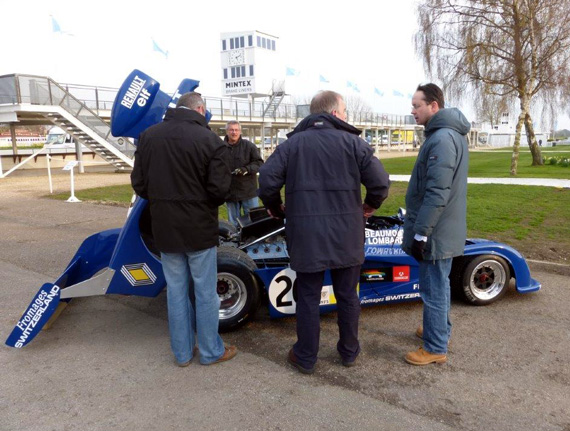
Technical inspection: Flavien (right) talks with Marcus Pye (center) at Goodwood in March 2014. (©Flavien and Vanessa Marçais).
The story of the A441-3 is then not yet over: Le Mans awaits and it’s sure the Le Mans Classic would be a great place to provide a momentous occasion to see this wonderful car in action again. Let’s hope they have enough fuel, when they do try!


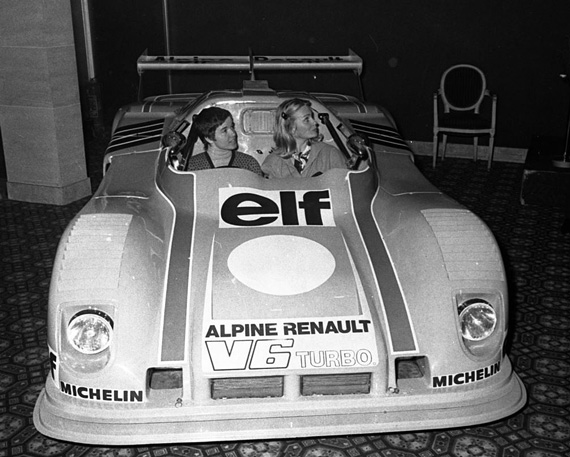
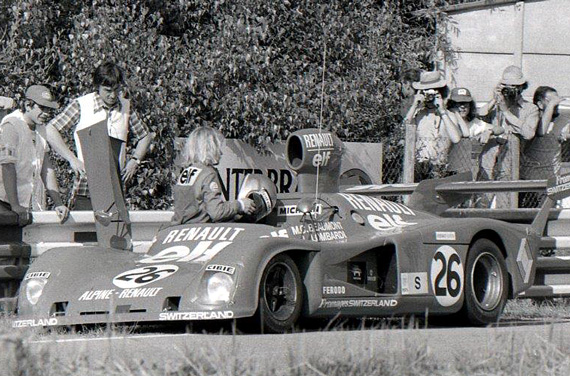
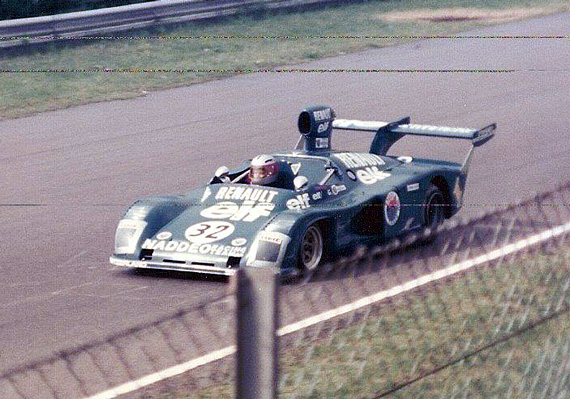
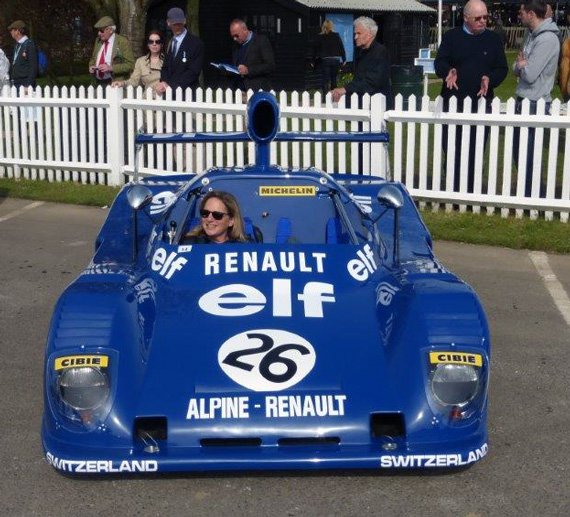
The author should read “on period french magazine” and ask Gérard Larrousse about which driver set the time during qualification… a woman ? nope !